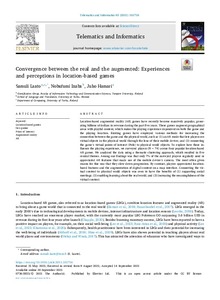Convergence between the real and the augmented: Experiences and perceptions in location-based games
Inaba Nobufumi; Hamari Juho; Laato Samuli
Convergence between the real and the augmented: Experiences and perceptions in location-based games
Inaba Nobufumi
Hamari Juho
Laato Samuli
ELSEVIER
Julkaisun pysyvä osoite on:
https://urn.fi/URN:NBN:fi-fe2021120158485
https://urn.fi/URN:NBN:fi-fe2021120158485
Tiivistelmä
Location-based augmented reality (AR) games have recently become massively popular, generating billions of dollars in revenue during the past five years. These games augment geographical areas with playful content, which makes the playing experience dependent on both the game and the playing location. Existing games have employed various methods for increasing the connection between the game and the physical world, such as (1) an AR mode that lets players see virtual objects in the physical world through the lens of their mobile device; and (2) connecting the game's virtual points of interest (PoIs) to physical world objects. To explore how these influence the playing experience, we surveyed players (N = 74) across four popular location-based AR games. We analyzed the data using a thematic clustering approach, which resulted in five central themes. Among our findings was that only 7% of the surveyed players regularly used or appreciated AR features that made use of the mobile device's camera. The most often given reason for this was that they slow down progression. By contrast, players appreciated locationbased features and the augmentation of digital content on a map interface. Connecting the virtual content to physical world objects was seen to have the benefits of (1) supporting social meetings; (2) enabling learning about the real world; and (3) increasing the meaningfulness of the virtual content.
Kokoelmat
- Rinnakkaistallenteet [19207]
